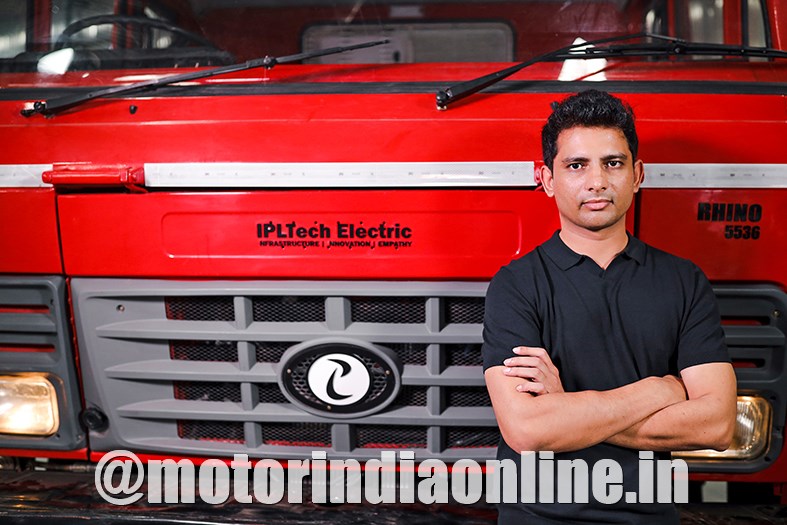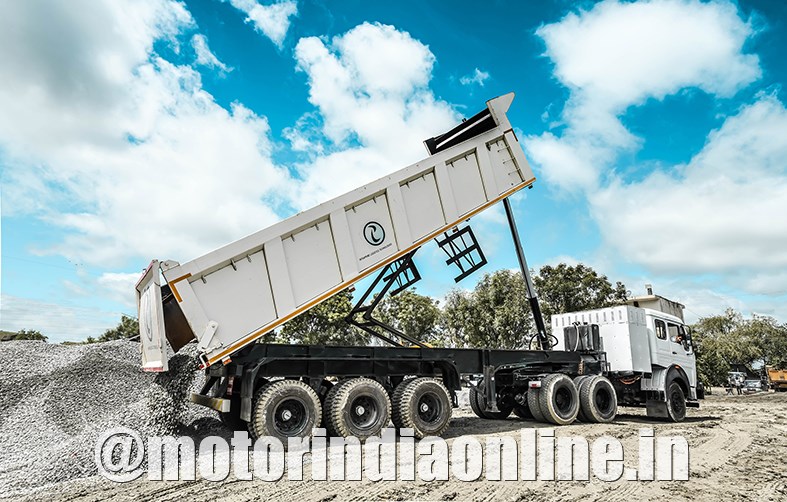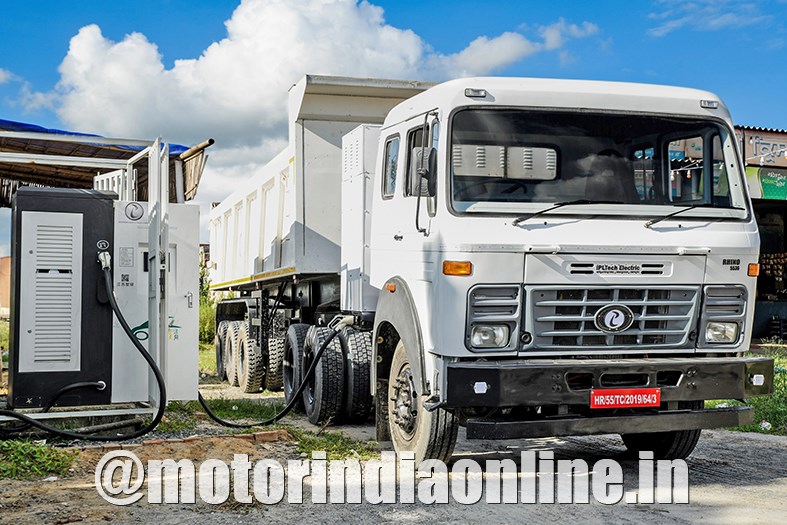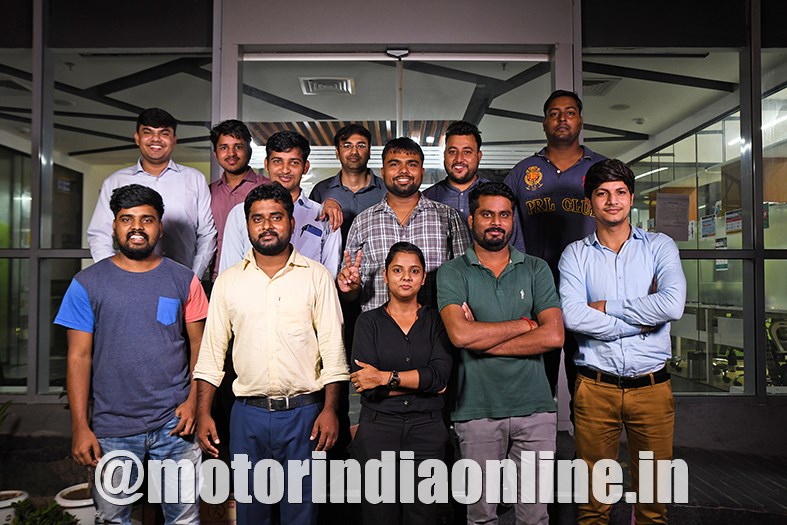Here is a constructions logistics technology company that has made the world’s heaviest 55 metric ton truck with automated manual transmission. The founder trio is high on ideas which are making stakeholders in both the business segments sit up and take notice. Infraprime Logistics or IPLT is a logistics technology-cum-truck building company and N. Balasubramanian peppers Subodh Yadav, CEO with questions and gains insights!

Two classmates, Subodh Yadav and Chetan Singhal, forged a friendship at IIT-Roorkee and a few years later the former met a colleague-turned-friend in Siddhartha Das. The trio, by way of work, realized pain points and service gaps in the construction logistics domain. And thus was founded Infraprime Logistics in 2017 to ‘halve the cost of infrastructure development through electric vehicles and data-driven vehicle management’.
Excerpts from the interview:
How did your trio decide to establish Infraprime Logistics?
About 7 years ago, Siddhartha and I were working on a project with Naya Raipur Development Authority. We noticed considerable gaps in the construction logistics market which were causing delays in the project. Simultaneously, Chetan was also facing similar problems and we set about analyzing the entire thing. We analyzed the demand and supply gap and created a matchmaking platform. But the fuel cost was the other major component. If the fixed cost of the fleet was 35%, the fuel cost was another 35%-40%. Since we brought the fixed cost down to 20%, we strove to bring down the fuel cost also from 35% to about 20%, which would be the real game changer for the entire industry. With that in mind, we began developing our own electric truck because the one in the market was prohibitively expensive. It took us one year and in 2019, we rolled out the first electric truck and now it is running near Kotputli, about 175 kilometers from Delhi on the Delhi-Jaipur highway. There are six routes that we are working on and we are also operating in Lucknow and Kolkata.

How did you work out the demand and supply gap using your technology?
Our platform has a suite of 3 applications and one of them is IPLT Humsafar meant for the truck drivers who can download the application, and fill in trip related details such as material being carried, its tonnage and the like. The same details are filled in at the unloading site also. The advantage is that we have completely bypassed some of the physical processes, and made the entire process online. Today, we have brought in about 1200 drivers online.
There are about 300 fleet operators on the fleet operator app through which they gain orders. Generally, the trucks go to the crushing zone which is Kotputli for us right now to pick up the load and come to the project sites which are near Delhi. The fleet operators get the entire order booking assistance, besides getting the vehicle level profit and loss statement.
Then there is a client app called TruckNow, which can be used to place their requirements for materials for example, and an interested fleet operator can take it up and fulfill the order.
There is a 4th app which is the crusher app meant for the crusher operator. The crusher operator can download the app and publish information related to the availability of material online to the fleet operators and drivers.
Infraprime was founded as a logistics technology service provider, and now has evolved into a truck maker. Would it be right to say that it is now more popular for the electric truck you’ve built than the app platform?
We prefer to call ourselves a logistics technology company, which also happens to develop electric trucks that were needed for our purpose. Last year, we split the company into IPL Tech Electric Private Limited which is purely about making and selling electric trucks, and the logistic company, which is a marketplace of trucks and deployment platform for the trucks in the construction logistics domain.
How did you get a heavy-duty construction truck to go electric? What gave you the confidence when even the big global names are still testing and trying the idea out?
The 55-metric ton truck category is the heaviest vehicle which is currently operating in India. There are only three companies in India which have the approval for such a truck but in diesel model. Infraprime is the first company which has an approved vehicle in that category. Even globally, the companies that have managed to make a vehicle have hit only 40-45 metric tons. So, this is a pioneering product globally.
If a vehicle that weighs 55 metric ton will need a high torque on wheels to move it and only maybe a 2 mega-watt motor can provide that kind of torque, but it has not been developed till now. And it will not be feasible to put it on a moving vehicle. So, we decided to develop an electric vehicle with transmission. We are the only company which has developed the simulation software for transmission based electric drive train and we are in the process of patenting it. With the help of the simulation software, we are able to reduce the product development time to less than 8 months. And the cost of product development is also quite low by industry standards.

How does your product differ from other global trucks available apart from them being transmission driven e-trucks?
There are a few differentiations, especially in the Indian context. Our battery pack is optimized to run at high temperatures also. If the ambient temperature is 50 degrees Celsius, we cool down the liquid that flows through each and every battery cell, ensuring the longevity of the battery.
The second USP is the gradient of the truck is highest in the class, even when compared to diesel trucks, because these trucks have to run through the mining zones. The gradient value for our truck is 28%.
The third factor is the regeneration. It allows the fleet operator to get the best mileage possible out of the electric truck. We capture much more energy through regeneration because mostly these heavy trucks keep accelerating and decelerating. Once high momentum is gained, then the amount of energy that can be retained through regeneration is also high. So, the architecture of the entire braking and the battery recharge system allows the drive train to feed that amount of current into the batteries. That way we recapture about 25% of the energy loss due to braking, and give it back to the battery.
The fourth differentiation is the motor efficiency. We use rightly programmed vehicle control unit which is our proprietary software. We programmed it to exactly align the duty cycle requirements where we keep capturing as our trucks run on the site. By aligning the vehicle control program with the duty cycle, we manage to keep the motor always at the sweet efficiency spot, which is 96-98% efficiency when you keep the torque and RPM between a certain range, giving us the highest mileage possible.
Tell us about the overall localization of the truck components.
About 90% of our components are sourced locally. Chassis comes from Indore, and axles from Ludhiana. Remaining 10% of the components like battery cells come from China and the motor is sourced from Taiwan. And these are high value components. It means about 40-50% of the value of the components are being sourced from China currently. But we have a strategy to move back to India over the next year and a half or 2 years. We have collaborated with a Faradion, a UK-based company, which is setting up a plant in India and is developing sodium-ion based battery chemistry which is almost as efficient as the lithium-ion based chemistry. Though slightly heavier they are cheaper. Once we start using sodium-ion based batteries, we will be 99% fully localized.
What will be the cost of operations for the fleet owners?
We have been running 2 trucks for the last one year, and then another nine trucks started plying since August 2020. These trucks are low on maintenance because there is no engine. So, the cost of maintenance on these trucks comes to about Rs. 4000, which is really related to the battery.
Tell us about the range of these trucks, and the charging aspect.
The construction logistics is all about routes and that is why these trucks are ideal vehicles. For example, Bhiwani in Haryana is about 1000 km from Delhi and if we set up charging stations at two or three locations on that particular route, we can service an entire fleet of 800 electric trucks.
Each charger needs Rs. 12 lakhs of investment to set up and the franchise operator guarantees at least 50,000 units of charging every month. These operators now are on board, and are getting 70,000 to 80,000 units for each charger. One charging bay is good enough to charge 8-10 tracks per day.
In our case, the franchise operators start earning from day one. Other than the construction logistics, these trucks are appropriate for closed loop running, say for example in plant areas.
The time taken for a charge from 5%-95% is about one and a half hour. Once fully charged, they can run for about 200 kilometers. If the return is empty, it can run for 300 km and when fully loaded, it can run for about 150 km.

What does the future roadmap look like for these trucks? How do you plan to scale up business?
We would like to first scale up on this route. And we want to go from 11 trucks at present to 100 in the next one year and then scale up to 500 trucks in 2 years. I think in the next 2 years, we want to hit 1000 electric trucks running different routes, out of which 500-600 will run on this route only. These electric trucks will displace about 600 diesel trucks coming into Delhi and they will be converted into electric and we will have a significant positive impact on the air quality of Delhi.
Do you have plans for other segments now that you have almost hit probably the most difficult segment that is still being worked out by global players?
Definitely, we have an advantage. We have plans to develop other models. So, we are developing 37 and 26 metric ton models. These will take 6-8 months and then these 4 models will primarily cater to all the segments of the M&HCV segment.
In India, there are about 200,000 trucks sold only annually in the M&HCV segment. Of this, about 80,000 are being sold to run on closed loops requirements and we want to capture a large portion of that through these 4 models.
Currently, all our attention is focused on making these two companies play a much larger role. In India, construction logistics is a US $ 10 billion market. We want to grow to 200-300 routes in construction logistics.
What is the initial cost of the truck in comparison to the diesel one?
The initial cost of the truck is almost twice that of the diesel one. But the returns on it will be three to four times. For example, if roughly Rs. 2 lakhs per month are made on the diesel truck, then with the electric truck, the returns will be about Rs. 6-8 lakhs a month.
What kind of an investment has been pumped into the company to develop these trucks, and what is your current turnover?
The turnover this year is roughly Rs. 140 crores for the logistics company. But the turnover for the electric truck company will be limited this year because we have only produced 11 trucks so far. The investment put into both the companies so far is US $10 million and we are raising another US $60 million.